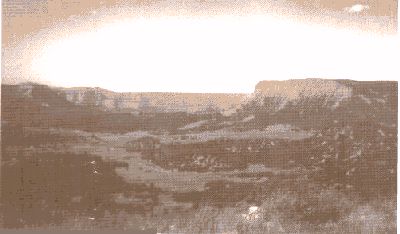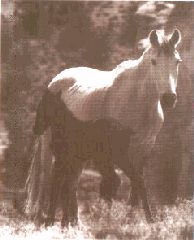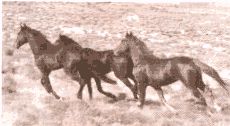
(Information and graphics courtesy of BLM, Colorado
District Office)
In the late 1800s the first horses brought to Disappointment Valley
belonged to a Montana rancher. The United States Calvary used this original
ranch stock for their mounts. In 1940 local residents removed most of the
herd, leaving behind a few horses which formed the present day herd.

 Use a "good neighbor policy" when traveling through this herd management area.
Leave gates as you find them. Please do not trespass on private or state
school lands. Access is available by permission only. These areas are
marked on the land status map available for purchase at the Durango BLM
office.
Use a "good neighbor policy" when traveling through this herd management area.
Leave gates as you find them. Please do not trespass on private or state
school lands. Access is available by permission only. These areas are
marked on the land status map available for purchase at the Durango BLM
office.
Following several years of severe drought, soil surfaces are fragile. The
off-road vehicle restriction is enforced. The Resource Management Plan
limits travel to designated roads only. Driving is also restricted through
the McKenna Peak Wilderness Study Area which covers 3,000 acres within the
Spring Creek Herd Management Area.

Recreational activities for you to enjoy include driving and exploring along
the Unaweep/Tabeguache Scenic and Historic Byway, camping, and fishing at
Miramonte and Ground Hog Reservoirs.

Go 18 miles south on Highway 141 to Gypsum Gap, County Road 19Q. Turn
South on CR-19Q for approximately 5.2 miles. Turn east on BLM Road 4010.
Herd area entrance is about 3.5 miles. For additional maps or further
information about this area, contact the San Juan Resource Area
Office.

Bands of Color
The herd runs about 50 head, primarily bays, sorrels, grays and paints.
Size
The horses are typically 14 hands high; weight 700 to 800 pounds
Diet
This HMA provides primarily salt desert valley vegetation consisting of
green rabbit bush, shadscale, black sage, Galleta grass, Indian ricegrass,
winterfat, and needle-and-thread.
Habitat
The Spring Creek Herd Management area covers 16,417. Terrain varies from
open rolling hills to rugged mountainous country to the north, south and east
boundaries. Elevations vary from 6,500 to 7,100 feet.
Wildlife
The HMA provides range for mule deer (winter), elk, coyote, golden eagles,
wintering bald eagles, peregrine falcons and prairie dogs. Occasionally bear
and mountain lions are sighted. Rattlesnakes are common in the basin
area.
Spring and Summer
For information on seasonal movements and migration patterns, please
contact the BLM Durango office for recent updates.
Best Chance for Viewing
Horses gather near surface springs and creeks within the basin. Water
tanks have been constructed to provide additional water sources for
wildlife.
Best Travel
Four-wheel drive is recommended. Most roads are primitive and will become
slippery if wet. Stay on designated roads o avoid getting lost or crossing
private land. Several dead-end roads exist in the area.
This is not a BLM operated or BLM sponsored site. It
is run by private wild horse and burro enthusiasts. We are thankful to the
BLM for providing the information which is presented here.

| 


 Use a "good neighbor policy" when traveling through this herd management area.
Leave gates as you find them. Please do not trespass on private or state
school lands. Access is available by permission only. These areas are
marked on the land status map available for purchase at the Durango BLM
office.
Use a "good neighbor policy" when traveling through this herd management area.
Leave gates as you find them. Please do not trespass on private or state
school lands. Access is available by permission only. These areas are
marked on the land status map available for purchase at the Durango BLM
office.

